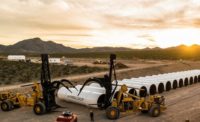
Citing long-term life-cycle costs, officials at Nevada Dept. of Transportation have awarded the first phase of the planned Boulder City Bypass to a contractor that proposed paving the highway section with concrete, despite this proposal costing $3 million more than the lowest bid, which planned to use asphalt.
"We opted to use concrete pavement due to its longevity, which federally funded studies show costs 13% to 28% less in the long run than asphalt," says Mary Martini, NDOT District 1 engineer. "It also reduces rutting and potholes, thereby cutting maintenance expenses by up to 75%."
Budgetary pressures have inspired more states to ask contractors to analyze life-cycle costs in bids. "The mechanism has been around a long time, but not everyone has taken advantage of it," says Tony Illia, NDOT spokesman.
The $83-million concrete contract awarded this month to Fisher Sand and Gravel was $3 million more than the low asphalt bid by Las Vegas Paving Corp. The state picked concrete after applying a life-cycle equivalency factor to the two approaches. It was first time the state had gone with a higher bid based on lower life-cycle costs, which, in this case, were expected to provide a $600,000 savings.
At a price tag of roughly $318 million for 15 miles of new road construction, the Boulder City Bypass along Interstate 11 would ensure the southeastern approach to Las Vegas from Hoover Dam will be at federal highway standards.
Phase one of the project is approximately 2.5 miles and includes improvements to what is now U.S. Highway 93 in Boulder City. The 2.5-mile-long project calls for building a four-lane freeway between Silverline Road and Foothill Drive, as well as a full diamond interchange at Railroad Pass with a loop ramp. The corridor currently sees 34,000 vehicles daily with heavy truck traffic.
Other components of phase one, expected to break ground April 6 and finish early 2018, include creating a 1.5-mile-long asphalt frontage road linking Henderson with the Railroad Pass interchange, replanting 20,000 cactuses, placing decorative rock and installing 5 miles of tortoise fencing. There will also be a 1,200-ft-long, 28-ft-tall cast-in-place concrete retaining wall with graphics illustrating scenes from the construction of Hoover Dam. It will act as the corridor's main visual element. The textured, multicolored retaining wall will be coated with a special anti-graffiti film that serves as a deterrent for taggers.
Construction on phase two is expected to begin in May; that project will have an asphalt roadway. The project's scope covers approximately 13.5 miles and will be managed by the Regional Transportation Commission of Southern Nevada. After construction is complete, maintenance and oversight will come from NDOT. On Feb. 12, RTCSNV awarded the $235- million contract for phase two to Las Vegas Paving Corp.
LVPC's original bid of $225 million was $63 million less than that of the nearest competitor, Eldorado Mountain Constructors, a joint-venture between Skanska and Granite Construction, according to RTCSNV. A joint-venture bid by Ames and Fisher was $300 million.
The final award pushed the contract amount to $235 million, which includes a $10-million owner contingency, says Mike Hand, director of engineering for RTCSNV. He said asphalt beat out concrete for this phase because daily traffic volumes are expected to be low.
Phase two work includes reconstructing and rerouting a 12.5-mile section of US highway 93 into Interstate 11. Work will begin adjacent to the NDOT/Fisher Sand and Gravel project. The new roadway will circle the Boulder City Municipal Airport and eventually connect at the Hoover Dam Bypass Bridge.
During bidding and planning, naturally occurring asbestos was discovered along the route, causing a delay of several months. By late 2014, the RTCSNV and NDOT concluded the asbestos was not a threat to public or workers, and eventually the Federal Highway Administration approved construction plans.




